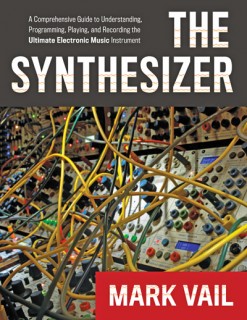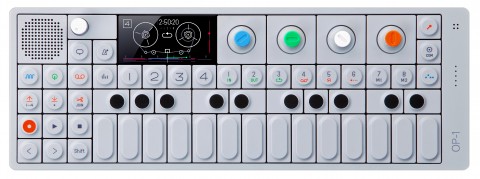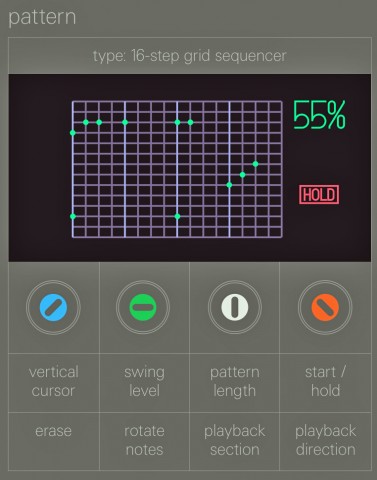Alternative Controllers: Part 3 from The Synthesizer by Mark Vail
Touch Controllers (continued)
Although it isn’t a dedicated controller, Teenage Engineering’s OP-1 — a tiny (11.1″ x 4.02″ x 0.53″, 1 lb. 4.4 oz.), battery-powered workstation packed with a variety of digital synthesis engines, effects processors, filters, audio recording and sampling, sequencing, and other capabilities — becomes a unique MIDI and CV controller with the addition of TE’s Oplab (4″ x 4″ x 1.25″, 9.5 oz. in its optional aluminum case). Oplab is an open-source “musical experiment board” that connects to the OP-1 via USB; provides MIDI I/O, a DIN-sync output for synchronizing pre-MIDI drum machines, a multi-pin expansion I/O rail, and CV and gate I/O for analog connections; and comes with a wall-wart power supply to run it alongside the OP-1. (The OP-1’s battery reportedly can run the device on its own for up to 16 hours.) The 24 Chiclet-style OP-1 keys don’t respond to velocity or pressure, but engaging any of its various sequencers can work effectively to drive and synchronize MIDI and analog instruments to make impressive sounds and music.
An overhead view of the Teenage Engineering OP-1. Its graphic display is phenomenal, so much so that I wish the OP-1 had a hi-res video output so an audience could see what’s happening on the screen during a performance. (courtesy of Teenage Engineering)
A Teenage Engineering’s Oplab, enclosed in its optional case, sits on a glass shelf to the left of an OP-1, beneath a Eurorack modular system, and above an Arturia BeatStep Pro in the author’s studio. Connected to the Oplab is a MIDI cable, the USB cable attached to the OP-1, and three cables connected to Eurorack modules. (Mark Vail)
You’ll get randomly triggered notes using the OP-1’s Tombola sequencer, a hexagon in which notes you play appear as blips that fall according to the level of gravity you dial in. You also adjust the spinning rate and direction of the hexagon and can open it up to eventually or quickly release all of the notes. Somewhat more conventional is the arpeggiator-oriented finger sequencer, which displays two virtual onscreen players that trigger programmed note patterns when you touch one or two OP-1 keys, plus a drum sequencer with two ape-like characters that play intricate drum patterns. There are also 16-step grid and 99-step digital sequencers, as well as an Etch A Sketch-style sequencer that generates notes according to two-dimensional drawings you make using the OP-1’s four digital-encoder knobs.
The Tombola spinning sequencer in Teenage Engineering’s OP-1 inserts dots inside the hexagon when you play notes. These fall toward the bottom at a rate determined by the gravity value you set using the OP-1’s green knob. Note masses, which you adjust using the orange knob, determined how hard they bounce off the inside surface of the hexagon, and the harder they bounce the louder the notes. The blue knob adjusts how fast the hexagon spins clockwise or counterclockwise. Enable “crank” mode by holding the OP-1’s shift knob and turning the blue knob; it’s called that because, using the optional crank device that slips over an OP-1 knob, you can manually spin the knob and control how fast the hexagon turns. Turn the white knob opens and closes the hexagon, allowing notes to drop or be thrown out through the openings. (courtesy of Teenage Engineering)
Two graphic players appear onscreen with the finger sequencer in the OP-1’s synthesizer mode. Play a single white note on the OP-1’s button keyboard and one of the players begins playing a sequence; add another note and the second player accompanies the first. Modes are also available to alternate between the players or have one player perform a fill pattern. You can enter up to 32 notes in finger patterns. (courtesy of Teenage Engineering)
In the OP-1’s drum mode, the finger sequencer features two gorillas who play drum patterns. In both modes, the green knob sets the level of playback swing, the white knob adjusts the length of the sequencer pattern, and the red knob can turn on hold so that patterns continue playing when you stop holding keys. (courtesy of Teenage Engineering)
Mono- and polyphonic patterns of up to 16 steps play under your interactive control in the OP-1’s 16-step grid sequencer mode. Using the instrument’s knobs, you can change the length of the playing pattern, shift notes one way or the other, enter and erase notes, change playback direction, and add swing to the playback feel. (courtesy of Teenage Engineering)
Use the OP-1’s knobs to draw freeform sequence patterns much like you’re using an Etch A Sketch. How do you erase a pattern? Pick up the OP-1 and shake it, just as you’d erase an Etch A Sketch drawing. (courtesy of Teenage Engineering)
Another groundbreaking alternative controller that offers rewarding musical expressivity is the Eigenlabs Eigenharp (http://www.eigenlabs.com). There are three Eigenharp models to choose from: the original, full-size Eigenharp Alpha, the mid-sized Eigenharp Tau, and the smaller, educational-oriented Eigenharp Pico. Performers can carry any of them around during performance. The larger Alpha and Tau each come with a supportive neck strap and have a “cello spike” if you’d rather stay in-place and play the instrument like a double bass. As for the Pico, it’s small enough to hold like a clarinet. One of the Eigenharp’s controllers is a breath pipe with an interchangeable mouthpiece for shared use. Another is at least one ribbon, depending on the model. You play notes using the Eigenharp’s keys, each of which senses velocity, side-to-side finger movements, and pressure. Pressure sensing is polyphonic for individual note expression. The Eigenharp Alpha and Tau connect via a multi-conductor cable to a Basestation interface, which comes in Standard and Pro versions. The Basestation is where you’ll find all of the interfacing connections.
Eigenlabs’ flagship Eigenharp Alpha, shown resting on its optional stand. The Alpha sports 120 note keys, 12 percussion-trigger keys, and two ribbons. (courtesy of Eigenlabs.com)
The most affordable Eigenlabs instrument is the Pico, which has 18 keys, four mode buttons, and a ribbon. Although you can’t tell from the photo, this is a Pink Pico, which costs a bit more than those with silver or black finishes. (courtesy of Eigenlabs.com)
A host computer — Macintosh or Windows PC — generates sounds for the Eigenharps, each of which comes with physical models of cello and clarinet, synthesis and sample-playback engines, a 6GB collection of multi-sampled Steinway grand piano and Rhodes and Wurlitzer electric pianos, and 1,500 drum and percussion loops. An Eigenharp can also trigger user sounds and software instruments. According to Eigenharp designer John Lambert, most of its players use Ableton Live, Steinberg Cubase, Apple Logic, or another host for AU and VST plug-ins. The Eigenharps allow extensive MIDI control and provide a routing matrix to eke the best out of the MIDI protocol. Lambert has been working with Steinberg so that the Eigenharps can drive their Note Expression feature via MIDI as well, supporting numerous ways of dealing with individual note expressivity including polyphonic aftertouch and channelized notes. Eigenlabs is also working on an extensive Open Sound Control (OSC) networking implementation to go with MIDI I/O. Jordan Rudess raves about Eigenharps, pointing out that they have the most responsive keys of any instrument he’s played and lightening-fast in touch response.
Eigenlabs’ Eigenharp Tau represents the midrange of their instrument lineup, having 72 note keys, 12 percussion-trigger keys, and one ribbon. The stand shown here is optional. (courtesy of Eigenlabs.com)
A view of the connection panel of an Eigenlabs Basestation Pro, revealing multi-pin jacks for the Eigenharp and an Extension, MIDI in and out, a USB 2.0 jack for connection to a computer, two ¼” input jacks for footswitches, two sets of ¼” jacks to serve as inputs and outputs for foot pedals, and a grounded IEC AC power jack. (courtesy of Eigenlabs.com)

Alternative Controllers: Part 4 from The Synthesizer by Mark Vail –











